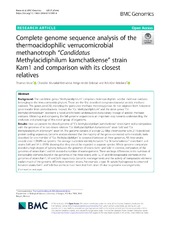| dc.contributor.author | Hansen, Thomas Kruse | |
| dc.contributor.author | Murarilal Ratnadevi, Chandini | |
| dc.contributor.author | Erikstad, Helge Andre | |
| dc.contributor.author | Birkeland, Nils-Kåre | |
| dc.date.accessioned | 2019-12-03T09:21:22Z | |
| dc.date.available | 2019-12-03T09:21:22Z | |
| dc.date.issued | 2019-08-09 | |
| dc.Published | Hansen, Murarilal Ratnadevi, Erikstad, Birkeland. Complete genome sequence analysis of the thermoacidophilic verrucomicrobial methanotroph “Candidatus Methylacidiphilum kamchatkense” strain Kam1 and comparison with its closest relatives. BMC Genomics. 2019;20:642. | eng |
| dc.identifier.issn | 1471-2164 | en_US |
| dc.identifier.uri | http://hdl.handle.net/1956/21046 | |
| dc.description.abstract | Background: The candidate genus “Methylacidiphilum” comprises thermoacidophilic aerobic methane oxidizers belonging to the Verrucomicrobia phylum. These are the first described non-proteobacterial aerobic methane oxidizers. The genes pmoCAB, encoding the particulate methane monooxygenase do not originate from horizontal gene transfer from proteobacteria. Instead, the “Ca. Methylacidiphilum” and the sister genus “Ca. Methylacidimicrobium” represent a novel and hitherto understudied evolutionary lineage of aerobic methane oxidizers. Obtaining and comparing the full genome sequences is an important step towards understanding the evolution and physiology of this novel group of organisms. Results: Here we present the closed genome of “Ca. Methylacidiphilum kamchatkense” strain Kam1 and a comparison with the genomes of its two closest relatives “Ca. Methylacidiphilum fumariolicum” strain SolV and “Ca. Methylacidiphilum infernorum” strain V4. The genome consists of a single 2,2 Mbp chromosome with 2119 predicted protein coding sequences. Genome analysis showed that the majority of the genes connected with metabolic traits described for one member of “Ca. Methylacidiphilum” is conserved between all three genomes. All three strains encode class I CRISPR-cas systems. The average nucleotide identity between “Ca. M. kamchatkense” strain Kam1 and strains SolV and V4 is ≤95% showing that they should be regarded as separate species. Whole genome comparison revealed a high degree of synteny between the genomes of strains Kam1 and SolV. In contrast, comparison of the genomes of strains Kam1 and V4 revealed a number of rearrangements. There are large differences in the numbers of transposable elements found in the genomes of the three strains with 12, 37 and 80 transposable elements in the genomes of strains Kam1, V4 and SolV respectively. Genomic rearrangements and the activity of transposable elements explain much of the genomic differences between strains. For example, a type 1h uptake hydrogenase is conserved between strains Kam1 and SolV but seems to have been lost from strain V4 due to genomic rearrangements.Conclusions: Comparing three closed genomes of “Ca. methylacidiphilum” spp. has given new insights into the evolution of these organisms and revealed large differences in numbers of transposable elements between strains, the activity of these explains much of the genomic differences between strains. | en_US |
| dc.language.iso | eng | eng |
| dc.publisher | BMC | en_US |
| dc.rights | Attribution CC BY 4.0 | eng |
| dc.rights.uri | http://creativecommons.org/licenses/by/4.0/ | eng |
| dc.subject | “Ca. Methylacidiphilum kamchatkense” strain Kam1 | eng |
| dc.subject | Full genome | eng |
| dc.subject | Methane oxidation | eng |
| dc.subject | Thermoacidophile | eng |
| dc.subject | Methanotroph | eng |
| dc.title | Complete genome sequence analysis of the thermoacidophilic verrucomicrobial methanotroph “Candidatus Methylacidiphilum kamchatkense” strain Kam1 and comparison with its closest relatives | en_US |
| dc.type | Peer reviewed | |
| dc.type | Journal article | |
| dc.date.updated | 2019-08-12T08:08:49Z | |
| dc.description.version | publishedVersion | en_US |
| dc.rights.holder | Copyright 2019 The Author(s) | en_US |
| dc.identifier.doi | https://doi.org/10.1186/s12864-019-5995-4 | |
| dc.identifier.cristin | 1715074 | |
| dc.source.journal | BMC Genomics | |

